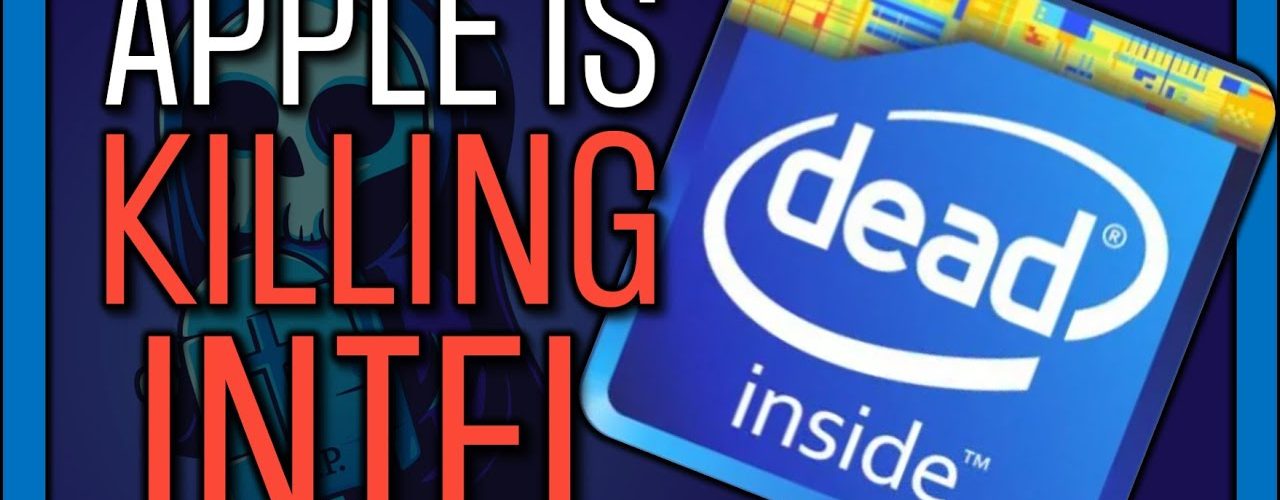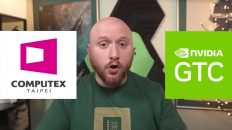Mentioned in Video:
- Find me on Twitter: https://twitter.com/TickerSymbolYOU
- My free Discord: https://discord.gg/9UHrHex4JX
- Channel Membership – Join the family!
- Not into YouTube Memberships but still want to support the channel? https://www.patreon.com/tickersymbolyou
- Support the channel and get extra member-only benefits by joining us on Patreon: https://www.patreon.com/tickersymbolyou
#ARKInvest‘s Big Ideas includes ‘Re-inventing the Data Center', where Cathie Wood states #Intel (INTC stock) has lost its way. Let's talk about #Apple (AAPL stock), Nvidia (NVDA stock), and Advanced Micro Devices (AMD stock), the 3 companies disrupting Intel's x86 processors by making their own ARM-based chips, and why Intel stock could be such a value trap.
Video Transcript:
[00:00:00.000]
The world is changing. Intel has been a household name in computing for decades, not just in consumer electronics, but also in servers and high demand workstations. Their X86 processors have over a 90% market share on servers today. Intel stock has rallied over 33% since the start of 2021. They pay a nice 2% dividend and have a price to earnings ratio of just 13, while the average for the S & P 500 is sitting north of 40. In this episode, I'm going to tell you why I believe Intel is the biggest value trap on the market and which companies are disrupting them.
[00:00:34.710]
It may not be obvious from my rugged exterior, but I'm actually quite a nerd. I love building computers and often find myself reading about the latest technologies from Intel and its competitors like AMD, Nvidia and even Apple. But the seriousness of Intel's problems were actually first highlighted for me this year when ARK Invest released their Big Ideas Report for 2021. Big Ideas is a publication that ARK Invest releases every year to talk about the technology platforms they think are going to change the world soon, like, starting now soon.
[00:01:04.530]
This year's Big Ideas Report is a whopping 112 pages long and features six entirely new big ideas. Right after Deep Learning, which in my opinion is the most impactful idea on the list, is a big idea titled The Re-Invention of the Data Center. In an interview with Tom Lydon for ETF Trends, Cathie Wood explained ARK Invest's projections for the computing demands associated with artificial intelligence, and the computing architectures they expect to meet those demands. Here's what ARK Invest thinks is killing Intel.
[00:01:34.200]
Human beings cannot possibly conceive of all the possible permutations out there when they're trying to program, let's say, an autonomous vehicle. It's not possible. But machines can train themselves, and Deep Learning is the way to do that. What's interesting about Deep Learning is training costs, like for autonomous vehicles, autonomous taxi networks, or for Alexa or for TikTok. Those training costs are dropping 37% per year, and the models, the artificial intelligent models built around Deep Learning are growing tenfold per year. So the computing power that we're going to need in the years ahead is enormous.
[00:02:25.370]
So we think that the market will scale to $30 trillion in opportunity in the AI space from 2 trillion. Now, that works out to a 17% CAGR or compound annual rate of return. You look at the green part of the bars. That's the Internet and you can see it will go. It will increase from 13 trillion to 20 trillion. But AI is going to be taking over in terms of growth trajectories. In fact, by the time 2037, the Internet will be very mature and the growth rate from 13 trillion to 20 trillion over that 17 year period actually equates to only 3%.
[00:03:16.130]
So the real growth is in deep learning, and it is the next big wave. Server processors will transform the next decade. Intel has dominated, Intel's x86 has dominated the data center. The servers in data centers, 92% of them have an Intel X86 processor. That is going to change dramatically. By the year 2030, we believe Intel's share of the data center will drop to 27%. 92% to 27%. Intel has really lost its way and we do believe that ARM and Risc-V are going to displace Intel.
[00:04:06.590]
They together will grow at a 45% annualized rate over the next ten years.
[00:04:15.510]
After doing my own digging, I think this big idea should really have been called architecting Intel's downfall. Your time is valuable, so I'll keep this short and sweet. Here's what I think really matters to us as investors. X86, ARM and Risc-V are processing architectures. Each architecture has its own assembly language, so switching between X86 and ARM isn't exactly easy. That means companies like Apple and Microsoft, which run many gigantic data centers and make tons of consumer electronics, really want to pick one processing architecture and stick to it.
[00:04:50.510]
X86 is Intel's processing architecture, and Intel's genius move in the 90s was to leverage the technology and scale of the quickly growing PC market. Just like Tesla's battery form factor leverages the quickly scaling consumer battery market. Intel's X86 chips have over a 90% market share in data centers today. But the PC market is no longer growing quickly while the mobile device market is. Here's how the chips inside them are different. X86 is a CISC architecture, which stands for complex instruction set computing.
[00:05:25.160]
It executes larger and more complex sets of instructions at a given time. This has two primary benefits, both of which are going away. The first benefit is that the processor does more work, which means the computer tends to need less RAM. Back when Ram was expensive, this was a very big deal. Today, not so much. And two, there are less lines of code overall, which is great for human programmers, but doesn't matter much for deep learning or other applications where the machines are writing the code instead of people.
[00:05:55.880]
The tradeoff for these benefits is that each line of machine code in complex instruction set computing is harder to execute, so the hardware tends to be more specialized. When I say harder, I specifically mean it takes more CPU cycles to execute an instruction, which means it takes more power, which also means more heat. As investors, we care about this a lot because power is expensive and heat requires cooling, which, you guessed it, also requires more power. The ARM and Risc-V instruction set architectures are, well, RISC-based. RISC stands for reduced instruction set computing.
[00:06:31.970]
RISC processing architectures are designed with mobile in mind, and they're scaling with the mobile device market today, just like CISC grew alongside PC technologies two decades ago. Basically, RISC breaks code down into much smaller chunks and execute one small chunk per cycle, so each chunk isn't as hard for a processor to execute, but there are many more lines of code to do a task. This tradeoff isn't always one to one, though, and RISC based architectures like ARM and Risc-V tend to use less power overall and generate less heat overall, which is why they're the architectures found in small, light mobile devices.
[00:07:10.580]
The other big difference between X86, ARM and Risc-V is that X86 doesn't support custom extensions, which means it can't be tailored for specific applications like video and audio compression, cybersecurity, cryptography. And, you guessed it, deep learning. Remember when I said big companies like Apple and Microsoft want to pick a processing architecture and stick to it? Well, picking the one that's lower power and more flexible seems like a no brainer. In fact, that's exactly what's starting to happen. Last year, Apple, ticker symbol AAPL, announced their transition away from Intels X86 chips to their own custom Silicon M1 chips, which are Arm based.
[00:07:49.430]
This huge transition from Intel's chips is already taking place. It started in the summer of 2020 and should wrap up completely in the middle of 2022. This all started with Intel disappointing its customers and shareholders for the last five years by promising to deliver their ten nanometer chips in 2015. Those chips still aren't out yet. For reference, we've been waiting just as long for the next Game of Thrones Book. Not delivering on your promises has big consequences. Remember, everything really boils down to managing power and heat.
[00:08:21.410]
The reason the 2016 MacBook Pro had so many major processing and overheating issues is because they were designed for Intel's new chip that never came. The intel chip that went into them instead had to get throttled way down and caused a lot of performance issues accordingly. Nobody likes poor performance. Apple's newer custom M1 chips like the ones that are in the recent MacBook Pros, the MacBook Airs and the new iMac are giving them huge reductions in power draw for the same amount of performance, which means they can offer better specs in the same size machine or keep making their machines lighter and smaller without sacrificing performance.
[00:08:58.460]
Let me be perfectly clear about what I'm saying here. Apple is a huge trend setter in computing. Apple stopped using Intel's chips, said they could do better themselves and now have been releasing product after product that proves it. What did intel do about it? Intel's lead chip architect Jim Keller stepped down right when Apple announced their transition, and earlier this year, Intel CEO Bob Swan stepped down as well. What did Intel not do about it? They didn't change their product roadmap to keep up with the demands for Arm processing chips.
[00:09:30.410]
Instead, the roadmap sticks to X86 as far as the eye can see, while they continued to fall further and further behind AMD and other chipmakers. What can you do about it? Well, unlike Intel, I'm always trying to find new ways to add value. If you're getting value from this video, consider liking it and subscribing. That lets me know as a content creator, what type of content I should focus on, and it really helps the channel out. What are other big tech companies doing about it?
[00:09:57.550]
Dumping Intel.
[00:09:59.030]
Intel under pressure once again because another key technology player wants to make its own chips. They want to make their own chips for servers and for their own computers. And this time, it's not Apple, but it's Microsoft and Intel getting cut out of that pie, are they gonna be using Arm Holdings design chips? So it helps Arm and of course, NVIDIA that's buying on, but, Romaine Bostick. This feels like such a trend that's moving and Romaine, what do you make of the sell of that we're seeing in Intel chip?
[00:10:23.420]
Yeah. I mean, look, this is kind of understood that when you saw Apple make this move, you sort of harkened back to that time when Intel really had to make a decision about whether it really wanted to really make these chips for these mobile devices. Intel decided to really sort of bank a future more on the PCs and the other types of more hard devices, servers and things like that. And it really pushed these companies to start thinking, how can we figure this out ourselves? Apple figured it out, and apparently Microsoft thinks it's figured it out now too.
[00:10:52.110]
And it's not really working out for Intel, is it Romaine. The shares are down 6%. As we head into the clothes, it's off more than 20% this year. It's like the 5th worst performing stock on the Nasdaq 100 this year. I mean, intel, as Caroline said, literally cannot catch a break.
[00:11:05.180]
Microsoft, ticker Symbol MSFT, is designing its own chips, which will be Arm-based. NVIDIA, ticker Symbol NVDA just had their latest GPU technology conference, or GDC, where they announced a few major products for data centers and consumers, none of which are using Intel's X86 chips. NVIDIA's Bluefield accelerated data processing units, or DPUs, have been running Arm processors for years. Their Super Pods, which is their commercially available super computers specifically designed for AI, will be using Arm-based chips in the future. And their DGX station, which is their server solution for data centers, runs X86 processors,
[00:11:45.950]
except they're made by AMD. And of course, that leads us to AMD themselves. Who has been eating Intel's lunch in the X86 market for the last few years and is already moving to Arm based architectures. I think there's a big disconnect between what's going on at Intel and their stock price. If we look at the year to date chart of Intel stock, ticker symbol INTC, we can see it's valued north of a quarter trillion dollars at some pretty low multiples compared to its peers. It even pays a dividend.
[00:12:15.320]
Hopefully you can see why I personally think Intel stock is a massive value trap. Sure, they can keep going up in the short term. But if they don't change directions soon, there's only one way the company is headed, and I don't plan to go down with it. This is Ticker Symbol: You.
[00:12:31.530]
My name is Alex, reminding you that the best investment you can make is in you.
If you want to comment on this, please do so on the YouTube Video Here














